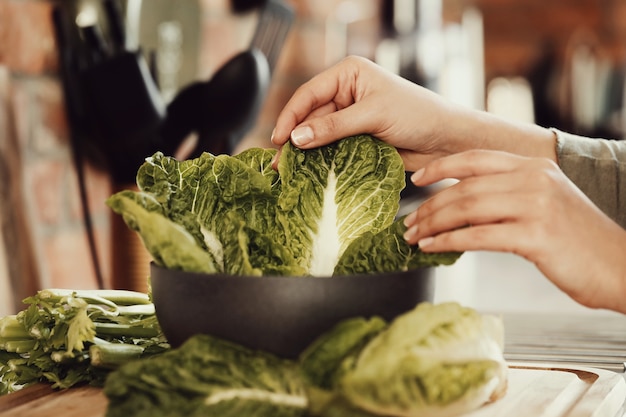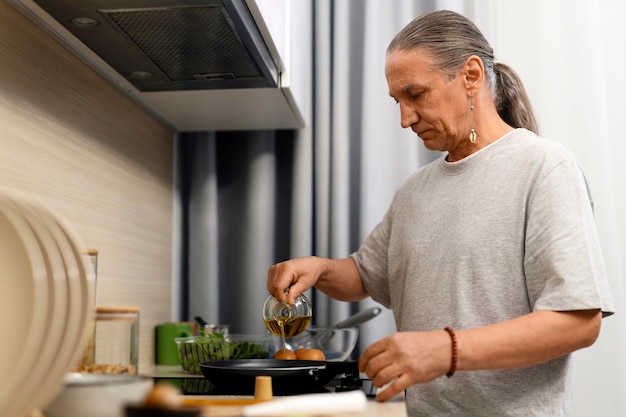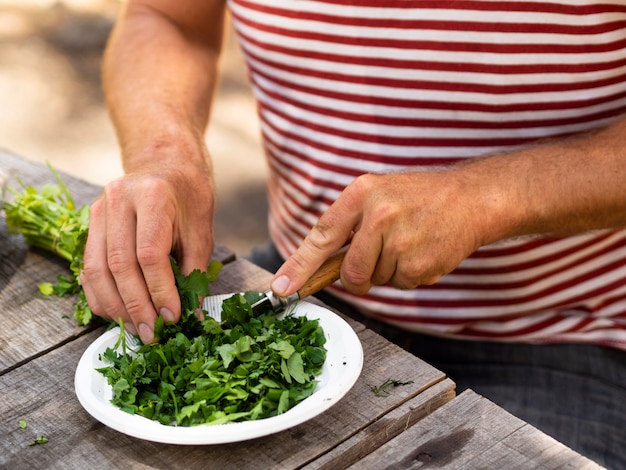You know that feeling, right? You’re scrolling through Instagram, and there it is – a picture of perfectly roasted kale. Crispy, golden-brown edges, glistening with olive oil, and just the right amount of salt – it's enough to make anyone's stomach rumble. As a seasoned chef and a self-proclaimed kale enthusiast, I've spent countless hours perfecting my own oven-roasted kale recipe. And let me tell you, it's not as simple as it looks! The key to unlocking the full potential of this leafy green lies in finding that sweet spot for cooking time.
Too long in the oven, and you'll end up with burnt, brittle leaves that are more likely to crumble than crunch. Too short, and they'll be limp and undercooked, lacking that delightful textural contrast we crave. But fear not! This comprehensive guide is your ultimate resource to mastering the art of oven-roasting kale. We'll delve into the different factors that influence cooking time, explore techniques to ensure perfect results every time, and share a few of my favourite tips and tricks. So, grab a bunch of kale, preheat your oven, and let's get started!
Part 1: Understanding the Basics of Oven-Roasted Kale

The Kale Chronicles: A Deep Dive into This Leafy Green
Kale, a member of the Brassica oleracea family, is a leafy green vegetable known for its nutritional value. It's a versatile ingredient that finds its way into salads, smoothies, soups, and even pasta dishes. But when it comes to oven-roasting, we need to understand the quirks of this leafy green:
- Kale Variety Matters: Different varieties of kale can have varying cooking times. Curly kale, with its crinkled leaves, tends to take longer to cook than lacinato kale, also known as dinosaur kale, which has smoother leaves. This is because the crinkles in curly kale trap more moisture, making it take longer to crisp up.
- Leaf Size: The size of the kale leaves also plays a role. Larger leaves may require a bit more time in the oven to achieve crispness. Think of it like a big, flat leaf having more surface area to crisp up.
- Stem Thickness: The thickness of the stems can also affect cooking time. Thicker stems will require longer cooking times to tenderise. Think of them as little bundles of fibre that take longer to break down.
Picking the Perfect Kale: A Guide to Selecting the Right Bunch
Selecting the right kale is crucial for achieving optimal results. Here's how to choose the best kale for roasting:
- Vibrant Green: Look for vibrant green leaves that are free of blemishes or yellowing. This indicates fresh, healthy kale.
- Sturdy Stems: Choose kale with sturdy stems. Avoid limp or wilted leaves, as they may have lost some of their moisture and won't roast as well.
- Organic Option: When possible, opt for organic kale for a more flavourful experience. Organic kale is often grown without pesticides, allowing the flavour to shine through.
Essential Tools for Your Kale Roasting Adventure
While oven-roasted kale doesn't require fancy equipment, a few tools will make the process easier and more enjoyable:
- Large Baking Sheet: For ample space to spread out the kale leaves, ensuring even roasting. Look for one that's large enough to hold the kale in a single layer, without overcrowding.
- Mixing Bowl: For tossing the kale with olive oil and seasonings. A large bowl makes this process easier, allowing you to thoroughly coat the leaves.
- Tongs: For easily moving the kale around in the oven and on the baking sheet. Tongs are great for flipping the leaves halfway through cooking, ensuring even browning.
- Kitchen Timer: To keep track of cooking time. A timer will prevent overcooking and ensure that your kale reaches its peak of crispness.
Part 2: The Anatomy of Perfect Oven-Roasted Kale

Signs of a Stellar Roast: How to Tell If Your Kale is Perfect
So, how do you know when your oven-roasted kale is ready? Here's what to look for:
- Crisp Texture: The leaves should be firm and slightly crunchy. They should snap when you bite into them, offering a satisfying texture.
- Golden-Brown Edges: The edges of the leaves should be slightly browned and caramelized. This is a sign that they have cooked evenly and developed those delicious, nutty flavours.
- Intensified Flavour: The roasting process concentrates the natural sweetness and earthiness of kale, making its flavour more pronounced. The roasting process brings out the best in kale, making it even more delicious.
Avoiding Common Mistakes: Pitfalls to Watch Out For
Even the most experienced cooks can make mistakes, especially when it comes to oven-roasted kale. Here are a few common pitfalls to avoid:
- Overcrowding the Baking Sheet: If the kale is too crowded, it won’t roast evenly. The leaves will steam instead of crisp up, resulting in a soggy texture. Leave some space between the leaves for airflow.
- Using Too Little Olive Oil: Olive oil helps to crisp up the leaves and adds a rich flavour. Don't be afraid to use a generous amount. Too little oil can make the kale stick to the baking sheet.
- Not Flipping the Kale Halfway Through: Flipping the leaves ensures even cooking on both sides. This helps to prevent some leaves from getting overcooked while others are still undercooked.
Part 3: The Crucial Element: Oven Temperature

The Heat Factor: The Perfect Temperature for Roasting Kale
Oven temperature plays a vital role in achieving the perfect roast. Most recipes call for a temperature of 400°F (200°C). This heat allows the leaves to crisp up quickly without burning. However, if you’re using a smaller oven or have a particularly thick batch of kale, you may need to lower the temperature slightly to prevent overcooking.
The Importance of Preheating: Why It's Crucial for Even Cooking
Preheat your oven to the desired temperature before adding the kale. This ensures that the oven is at the correct temperature when the kale goes in. Preheating allows the kale to cook evenly and prevents it from steaming, which can make it soggy. Think of it like starting a fire – you need to let the flames get going before adding the wood.
The Science Behind High Heat: How It Creates That crispy texture
The high heat of the oven helps to dehydrate the kale leaves, which contributes to their crispy texture. As the water evaporates from the leaves, the sugars caramelize, creating a sweet and slightly nutty flavour. It's a process of transformation, turning those tender leaves into delicious, crunchy delights.
Part 4: The Art of Timing: Cooking Time Variations
Factors Affecting Cooking Time: Understanding What Influences Your Roast
Cooking time for oven-roasted kale can vary depending on several factors, including:
- Type of Kale: Curly kale generally takes longer to roast than lacinato kale due to its crinkled structure and higher moisture content.
- Size of Leaves: Larger leaves will take longer to cook than smaller leaves because they have more surface area to crisp up.
- Thickness of Stems: Thicker stems will require a bit more time to soften. It's like cooking a thicker piece of meat – it takes longer to cook through.
- Oven Temperature: A higher temperature will reduce cooking time. The hotter the oven, the faster the leaves will crisp up.
- Quantity of Kale: More kale will take longer to cook than a smaller batch. Think of it like a crowded baking sheet – it takes longer for the heat to reach all the leaves.
A General Guideline for Cooking Time: A Starting Point for Your Roast
As a general rule, oven-roasted kale should take between 10 and 20 minutes to cook. For most varieties, start checking for doneness around the 12-minute mark. Remember, this is just a guide, and your cooking time may vary depending on the factors mentioned above.
The Importance of Checking Regularly: How to Ensure Perfect Results
It's essential to check the kale periodically to prevent overcooking. Start by checking the leaves after 10 minutes, then every 2 minutes after that. You'll know it's ready when the leaves are crispy, golden-brown, and snap when you bite into them.
Part 5: Mastering the Technique: How to Roast Kale Like a Pro
Step-by-Step Guide to Oven-Roasted Kale: A simple recipe for Success
Follow these simple steps for perfect oven-roasted kale:
- Preheat Your Oven: Preheat your oven to 400°F (200°C). This ensures even cooking and prevents the kale from steaming.
- Wash and Dry the Kale: Wash and dry the kale leaves thoroughly. Remove any large stems.
- Toss with Olive Oil and Seasonings: In a large bowl, toss the kale with olive oil, salt, and pepper. You can add other seasonings like garlic powder, onion powder, paprika, or red pepper flakes for extra flavour.
- Spread on a Baking Sheet: Spread the kale in a single layer on a large baking sheet, making sure the leaves are not overlapping. This will ensure even roasting.
- Roast in the Oven: Roast for 10-20 minutes, or until the leaves are crispy and golden brown. Check the leaves every few minutes to prevent overcooking.
- Flip for Even Browning: Flip the kale halfway through cooking for even browning. This ensures that both sides of the leaves get crispy.
Tips for Enhancing Your Roasting Experience: Elevating Your Kale Game
Here are some tips to take your oven-roasted kale to the next level:
- Use Quality Olive Oil: Use a good quality olive oil for a richer flavour. extra virgin olive oil is a great choice.
- Experiment with Seasonings: Experiment with different seasonings. Garlic powder, onion powder, paprika, and red pepper flakes are all delicious additions. You can also try herbs like rosemary or thyme.
- Add a Squeeze of Lemon Juice: Add a squeeze of lemon juice for a bright and tangy flavour. Lemon juice cuts through the richness of the olive oil and adds a refreshing touch.
- Top with Your Favourites: Top the roasted kale with your favourite toppings, such as Parmesan cheese, toasted almonds, or dried cranberries. These toppings add texture and flavour to the kale.
Part 6: The Flexibility of Oven-Roasted Kale
Kale for Salads: Adding Crunch and Depth to Your Green Dishes
Oven-roasted kale adds a delightful crunch and depth of flavour to salads. It pairs well with a variety of ingredients, such as roasted vegetables, quinoa, and grilled chicken or fish. Think of it as the perfect textural counterpoint to those softer ingredients.
Kale as a side dish: A Healthy and Satisfying Accompaniment
Oven-roasted kale makes a healthy and satisfying side dish for any meal. It complements hearty dishes like roasted chicken, pork chops, or steak. It's the perfect way to add a dose of greens to your meal.
Kale in Soups and Stews: A Nutrient-Rich Addition to Hearty Dishes
While oven-roasted kale is typically enjoyed as a side dish or salad ingredient, it can also be added to soups and stews for a boost of nutrition and flavour. Think of it as a stealthy way to sneak in more greens.
Kale for Breakfast: A Delicious and Healthy Way to Start Your Day
For a healthy and satisfying breakfast, try topping your oatmeal or yoghurt with oven-roasted kale. The crispy leaves add a fun textural contrast and a unique flavour. It's a great way to add a bit of crunch and excitement to your morning routine.
Part 7: Beyond the Basics: Variations on Oven-Roasted Kale
Sweet and Savoury Variations: Exploring New Flavour Profiles
Experiment with different flavours and ingredients to create unique variations on the classic oven-roasted kale recipe. Here are a few ideas:
- Maple-Glazed Kale: Toss the kale with maple syrup, soy sauce, and sesame seeds. This sweet and savoury glaze creates a delicious and addictive flavour combination.
- Lemon-Garlic Kale: Add a squeeze of lemon juice and minced garlic to the kale before roasting. This combination is light, bright, and full of flavour.
- Spicy Kale: Add a pinch of red pepper flakes or cayenne pepper for a kick of heat. This is perfect for those who enjoy a little spice in their food.
- Cheesy Kale: Sprinkle shredded Parmesan cheese over the kale in the last few minutes of cooking. The cheese melts over the kale, creating a delicious and cheesy flavour.
Creative Combinations: Pairing Kale with Other Ingredients
Combine oven-roasted kale with other ingredients to create delicious and satisfying dishes. Here are a few ideas:
- Kale and roasted sweet potatoes: Roast kale and sweet potatoes together for a healthy and flavourful side dish. The sweet potatoes provide a contrasting sweetness to the kale's earthy flavour.
- Kale and Sausage: Pair oven-roasted kale with italian sausage for a hearty and satisfying meal. The sausage provides a rich and savoury flavour that complements the kale perfectly.
- Kale and Chickpeas: Toss roasted kale with chickpeas, tahini, and lemon juice for a Mediterranean-inspired dish. This combination is healthy, delicious, and full of flavour.
Part 8: The Storage Solution: Keeping Your Kale Fresh
Storing Fresh Kale: Maintaining Freshness in the Fridge
To keep your kale fresh, store it in the refrigerator in a plastic bag or container. Make sure to wash the leaves and pat them dry before storing. You can also wrap the kale in paper towels to absorb excess moisture. This will help to prevent the kale from wilting and keep it fresh for longer.
Freezing Kale for Later Use: Preserving Kale for Future Dishes
You can freeze kale for later use. Wash, dry, and chop the leaves. Then, place the kale in a freezer-safe bag and store it in the freezer for up to 3 months. When you're ready to use it, thaw the kale in the fridge overnight.
Reheating Oven-Roasted Kale: Enjoying Those Delicious Leftovers
If you have leftovers, you can reheat them in the oven or microwave. To reheat in the oven, preheat the oven to 350°F (175°C) and bake the kale for 5-10 minutes, or until heated through. To reheat in the microwave, heat the kale in a microwave-safe container for 1-2 minutes, or until heated through.
FAQs
Q1: Can I roast kale with other vegetables?
Absolutely! Oven-roasted kale pairs well with other vegetables, such as Brussels sprouts, sweet potatoes, carrots, and onions. Just make sure to adjust the cooking time accordingly, as different vegetables have different cooking times.
Q2: Can I use frozen kale to roast?
Yes, you can use frozen kale to roast, but it will require a bit more cooking time than fresh kale. Make sure to thaw the kale before roasting and pat it dry. You may also need to add a little extra olive oil to prevent the kale from sticking to the baking sheet.
Q3: How long can I store oven-roasted kale in the fridge?
Oven-roasted kale will last in the fridge for up to 3-4 days. Store it in an airtight container to prevent it from drying out.
Q4: Is it possible to overcook kale?
Yes, it is possible to overcook kale. If the kale is roasted for too long, it will become burnt and brittle. Check the leaves periodically to make sure they are not getting too brown.
Q5: What can I do with leftover kale stems?
Kale stems are edible and can be used in soups, stews, or stir-fries. You can also chop them up and add them to smoothies for a boost of fibre and nutrients. They are a great way to use up those often discarded parts of the kale.
Everyone is watching

Corn on the Cob: The Ultimate Guide to Perfectly Cooked Ears
Healthy MealsAh, corn on the cob. Just the name evokes images of sunny days, barbecues, and that sweet, juicy flavour that ...

Perfect Pork Roast Oven Cooking Time: A Guide to Delicious Results
Healthy MealsThere's something truly satisfying about a perfectly roasted pork. The aroma alone is enough to make your mout...

Ham Cooking Time: How Long to Bake, Smoke, or Boil a Delicious Ham
Healthy MealsAh, ham. It's a classic, isn't it? A real crowd-pleaser, especially around holidays. And when done right, it'...

Scallops: The Ultimate Guide to Perfect Cooking
Healthy MealsAh, scallops. Those delicate, sweet, and utterly delicious morsels of the sea. They hold a special place in my...

Spaghetti Squash: The Ultimate Guide to Cooking and Serving
Healthy MealsRemember that time you saw spaghetti squash at the supermarket, looking all bumpy and strange, and thought, "W...
